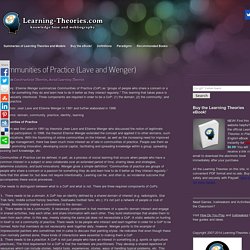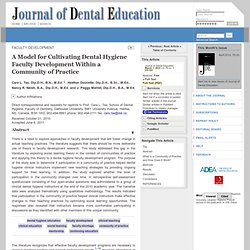

Communities of Practice (Lave and Wenger. Summary: Etienne Wenger summarizes Communities of Practice (CoP) as “groups of people who share a concern or a passion for something they do and learn how to do it better as they interact regularly.”

This learning that takes place is not necessarily intentional. Three components are required in order to be a CoP: (1) the domain, (2) the community, and (3) the practice. Originators: Jean Lave and Etienne Wenger in 1991 and further elaborated in 1998. Key Terms: domain, community, practice, identity, learning Communities of Practice The term was first used in 1991 by theorists Jean Lave and Etienne Wenger who discussed the notion of legitimate peripheral participation.
Communities of Practice can be defined, in part, as a process of social learning that occurs when people who have a common interest in a subject or area collaborate over an extended period of time, sharing ideas and strategies, determine solutions, and build innovations. There needs to be a domain. Jean Lave, Etienne Wenger and communities of practice.
Contents: introduction · communities of practice · legitimate peripheral participation and situated learning · learning organizations and learning communities · conclusion · references · links · how to cite this article Many of the ways we have of talking about learning and education are based on the assumption that learning is something that individuals do.

Furthermore, we often assume that learning ‘has a beginning and an end; that it is best separated from the rest of our activities; and that it is the result of teaching’ (Wenger 1998: 3). But how would things look if we took a different track? Supposing learning is social and comes largely from of our experience of participating in daily life? It was this thought that formed the basis of a significant rethinking of learning theory in the late 1980s and early 1990s by two researchers from very different disciplines – Jean Lave and Etienne Wenger. Dentistry, Dental Practice, and the Community - Brian A. Burt, Steven A. Eklund.
A Model for Cultivating Dental Hygiene Faculty Development Within a Community of Practice. Cara L.

Tax, Dip.D.H., B.A., M.Ed.⇓, Heather Doucette, Dip.D.H., B.Sc., M.Ed., Nancy R. Neish, B.A., Dip.D.H., M.Ed. and J. Peggy Maillet, Dip.D.H., B.A., M.Ed. + Author Affiliations Direct correspondence and requests for reprints to Prof. Abstract There is a need to explore approaches in faculty development that will foster change in actual teaching practices. The literature recognizes that effective faculty development programs are necessary to improve teaching practice and support professional growth.1–16 However, attendance at didactic sessions may have little effect in changing the teaching practices of participants.17 Most faculty development initiatives are formal programs such as workshops and seminars,1,9,16 in which there is little opportunity to help faculty members implement new knowledge and teaching skills in the workplace.
Haden et al.7 reported a scarcity in the literature on outcomes of faculty development initiatives in dental schools. Methods The Seminar Series Table 1.